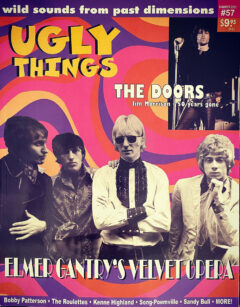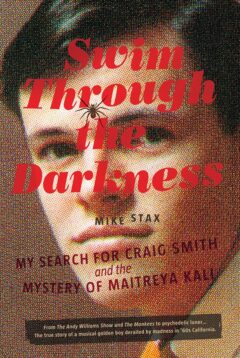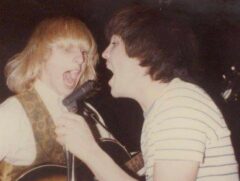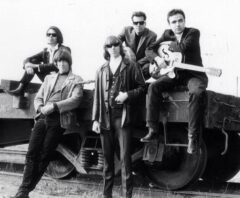Cover Story
MIKE STAX: Music Archaeology and the Science of Diggin’ It
Records are like photographs in that they capture a moment in time, except with sound instead of light. You listen to music all the time, made by people who died, dissipated, or just dropped off the map decades ago, yet left those records behind as the torch of their legacy. For the Beatles, Stones, Kinks, and the Who, that legacy will feed their families for generations to come. For others, the records they have left behind are all that is left.
For every rolling stone there is a nugget, or a pebble, that trails along in its wake. Some you even know by now, but there are many that have been buried by the sands of time. Records, captured moments sit forgotten in the attics and basements of people who long ago were a part of something they now see as irrelevant, not something to be relived, maybe to them wasn’t even that big of a deal, or better left in the dust.
Enter Mike Stax. The subject of Music Archaeology is so unpopular that I may have made up the term just now on the spot, but it is a perfect description of what he does. He has no interest in telling the stories that have already been told about the musicians you already know everything about. He’s dedicated the better part of his life to putting out Ugly Things magazine and turning you on to those forgotten bands whose records only see the light of day because of the work that he does, and sometimes in their own words. Subjects of Ugly Things stories have become regular contributors to the rag such as Cyril Jordan from the Flamin’ Groovies, Don Craine from the Downliners Sect, and legendary musician/writer/journalist Lenny Kaye.
The maiden voyage for Ugly Things embarked (or is it disembarked?) in 1983, while Stax was making his bones playing bass for the Crawdaddys, who, probably not uncoincidentally were the kind of band Ugly Things would cover—just talented enough to write some great tunes and get them down on some records, yet unable to hold the ship together or navigate the muddy waters and complications that come with the nature of the biz at the time, and so collapsed under its own weight despite so much inherent potential. Coincidence? Maybe.
The magazine, however, has been surviving and thriving for all these years, a testament to not only the work he’s put into it but also to the voice he’s been able to give to those who otherwise would have none, and also to the interest in hearing what those voices have to say. The distribution is worldwide and has at points inspired others to follow in its footsteps.
The mag is dense, with feature stories covering 20 or 30 pages, and I mean small-type, get-your-granny-glasses-on print in which his passion for the people he interviews shines through. To do it for any other reason wouldn’t make sense; that’s how you can tell it’s the real deal. It’s how he’s been able to gain access not only to groups who caught a couple rays of sunshine then dropped into the ether, but also to bands who were so close to the big time they could frickin’ taste it—like the Pretty Things, who were maybe one business savvy member away from a real breakthrough, hung around for quite a few years actually, but never had the wings of destiny nor the hand of fate smiled upon them.
Tales of wildness and mayhem are enough to give merit to singer Phil Mays’ story, but Stax digs in to where it all came from, details of his childhood, art school with Keith Richards, dinner with Judy Garland, and a particularly raucous tour of New Zealand, which was so good the book wrote itself. Don’t Bring Me Down…Under is yet another read you need to look up, buy, and throw on that pile of books you haven’t gotten to yet until you do and beat yourself up over why you didn’t do it sooner you pathetic loser, whassa matter with you?
***************
Great Moments in History
June 12, 1941
Southeast corner of National and Washington. Culver City, California
T-Bone Walker spends six electrifying hours blowing the doors off of the Cotton Club
in Los Angeles, backed by Les Hite and his Orchestra.
Later that night, 14-year-old Jimmy Lewis, who had snuck into the audience, immortalizes himself for time immemorial when at home and in the act of lip syncing to records and performing for an audience of the dog, grabs a tennis racket and begins strumming. It is the first noted instance of such an occurrence in the entire history of mock tennis racket guitar solos, and while the dog didn’t seem to think much of it at the time, she had to admit many years later that Lewis had definitely opened the door that unleashed floodgates of wanna-be racket slingers for many generations to come.
***************
Stax agrees to meet me on a swampy, sweltering afternoon at his house in La Mesa. He’s inviting me into his home so he obviously doesn’t remember me. So good, so far. He didn’t bother to dress up for his dressing down, but that’s okay. Who does? He’s got a good air. A relaxed, welcoming vibe. It’s warm but I can’t tell if that’s him or if it’s because goddam, it’s hot today.
He’s just finished the Fall ’21 issue of Ugly Things and is looking into booking some gigs for the Loons, the band he started in 1996 with his wife.
Anja Stax is the käse to his spätzle, a real time machine of a girl, sploshette moxy, a cool, refreshing drink from a bubbling brook who saunters in and out of the room like a Joe Meek freak beat, a futuristic throwback whose boots make their go-go rocking the Rickenbacker bass guitar for local katzenjammers the Rosalyns, when she’s not playing clubs with the hubs. The chick’s got some busy bees in her own hive, and together Mike and Anja make a great team whether it be playing together in a band, doing DJ sets, or raising their son, Philip (named after the aforementioned Phil May).
While the missus supplies the Loon boom boom, Chris Cancelliere brings the bam bam, Chris Marsteller and Marc Schroeder come in with the wang dang doodle, and Mike’s reverb drenched vocals sit right out front.
You might have seen the Loons around town. They’ve got a real rock ‘em, sock ‘em mashed potato liquid light psych-out groovy vibe with more platform paisley Pablo Fanque funk than this scene has seen since the perils of Pauline. If you like to see Ginny dress in a mini dress, Lucy wants to watusi, or Jim’s got a jones for bell bottom betties, this band just might be your jam.
Mike Stax knows the game. That’s what’s great. He’s spent a lot of time on both sides of the microphone, and I can tell that his talent at getting interviews from people also translates into his ability to give them. He doesn’t need to be prodded into talking about the work he does. He’s got fire. He’s got heart.
Tall, lanky, erudite, with a tow-headed mod cut, Stax fashions some big, dark, black sunglasses to feel like he thinks he can hide the truth from me (he can’t), and a British accent that 40 years of living in the USA hasn’t diluted in the slightest.
He doesn’t say rekkerds like you slimy low-brow Americans do. He says rah-kewrds like a true upper crust sophisticate, thinking he’s all better than you and stuff. Then he says facking brilliant! and you realize that no, that’s not it at all, it’s just the accent; this guy is one of us, and it makes you appreciate how colorful and versatile a thing the British accent can be—suave one moment, tawdry the next and it joost makes you bloudy joulous o’ the bloke.
San Diego Troubadour: I just told you a bunch of stuff I don’t want you to talk about. Now I want you to talk about exactly that. Tell me about who you are.
Mike Stax: I was born and raised in England, came to San Diego when I was 18, right out of school, and I’ve pretty much been here ever since. I’m a musician, writer, and magazine publisher.
SDT: You’re the publisher of Ugly Things magazine, a garage rock thing based mostly off the underground music of the ’60s.
MS: You could say that. It’s basically a rock ‘n’ roll history magazine. And it’s not strictly garage rock. We cover ’70s punk rock, psychedelia, rockabilly, blues, and all kinds of music. The ’60s is the main era we cover, but we also go into the ’50s and the ’70 s as well.
SDT: Is the gist of the thing that you are covering the kind of music that isn’t normally covered by popular music mags? You’re digging deep into the well of things instead of just doing the mainstream acts that have already been covered to death by now.
MS: Exactly. And you know, as a music fan I like to dig and find obscure records and obscure bands, and I want to get their stories because there’s already hundreds of books about the Beatles and the Stones and Bob Dylan and Jimi Hendrix and the Doors, all of whom are great, but their stories have been told. Why tell them again? Why keep telling them? Let’s tell the story of the neighborhood teenage garage band from the ’60s, or some band from Holland or Australia or Turkey. Let’s find some interesting stories that you haven’t read before.
SDT: What’s the deepest you’ve dug so far? What’s the most ancient artifact you’ve unearthed over the 40 years you’ve been at this now? What’s the dirtiest your hands have gotten?
MS: Oh wow, I mean, they all require a lot of digging. A lot of the stories are just about bands that had one 45 that came out years ago. As far as the deepest I’ve dug was probably for the book that I wrote, Swim Through the Darkness. I was digging for 15 years.
SDT: …and we’re coming to that. You’re getting a little bit ahead of me. Is there somebody you’ve been looking for that you haven’t found yet?
MS: That’s a really great question. I’m trying to think of who would be at the top of that list…I want to talk to this band from Vienna, Austria called the Slaves. I’ve got a line on the guitar player. He’s now a jazz guitarist, but back then he was like a 15-year-old prodigy. A gypsy. An amazing guitar player. They made just three 45s, all released at the same time, and every one of them was incredible. I really want to talk to them. I’m not really sure if they even speak English. They sing in English so I’m assuming they do. That’s the top of my list right now.
SDT: A lot of people sang in English and couldn’t understand any of the words to the songs they were singing. That’s a very common occurrence.
MS: Right, then how good of an interview could I do? But presuming they speak German then Anja’s German, so I’ll put her into play and that might work.
SDT: If we’re talking about the ’60s, to get back to that topic for a minute, what I want to know is why you listen to that music today and it still feels relevant in comparison or in contrast to the music that is put out today, which is seemingly a much more disposable product that becomes obsolete mere moments after it’s released.
MS: I think it was a realization I came to when I was in my teens that maybe I’d missed out on the best era of music. I was 15 in 1977, living in England when punk rock broke out, ’76 really.
SDT: Did you feel like you were born just a bit too late?
MS: That was exciting, but it kind of flared out really fast. All those bands’ first records were really good and all their second ones were less good, and I just found I was digging more and more into the music of the ’60s. It seemed to just have this more timeless quality, something more exciting, less calculated. I think that now, having been into it for so long and trying to make sense of it, I think somewhere along the way the people that ran the business figured it out. When the Beatles broke onto the scene and everything in their wake, the record industry wasn’t ready for it. They didn’t know what that was. It was the first time where bands were sort of self-contained and writing their own material. You didn’t have to be a professionally trained songwriter or musician to make the music. In the past, they used to really put things together with producers and songwriters, singers and musicians were all separate skill sets that would be put together in the studio by the record company. All of a sudden the Beatles came along and it’s a totally different game.The other thing is that they were working class; they all came from the working classes, and the music industry was run by the middle class and upper-class people who didn’t really understand. They [the Beatles] opened the doors for all the people that were working class or lower middle class who were saying to themselves now, “We can do this. We can do this ourselves. We can have our own band just with our friends from the neighborhood.” And the result was some very pure music because it was being played by the people who were creating it and relatively untouched by producers. I mean, producers still had a role in everything but the bands had this amazing wave of creativity that was not tampered with. It wasn’t calculated. It was before they had focus groups and such and it was when they would still sign a band and let them make two or three records or maybe even albums before they decided it wasn’t working out.Now, or for the past 40 years, if your first album doesn’t sell 100,000 copies, you’re going to get kicked off the label. There’s nothing about building an act or allowing an act to grow. In the ’60s everything came together in a way where it was untampered with and it just seems to stand up better.
Another thing I always think about is: those bands, it wasn’t a career choice at that point. People didn’t get into that business to have a career to extend long into the future. They just did it to make music. Maybe they did it to make a little bit of money but the common wisdom was that it would last two or three years. You even see interviews with the Beatles in ’64 talking about opening a hairdressing salon when it was all over with. Ringo was saying that. Paul was talking about how maybe he and John would write songs for other people and so forth. So there wasn’t that strategy, that sort of ruthless careerist kind of approach to music. It was just all for the joy of making it right then, and getting out of it what you could in the moment, and that makes for great music.
SDT: If you take the ’60s as a decade there were some huge changes going on not just in the music sense but also in the cultural, technological, political, and historical sense that had a profound effect on the grand scheme of how we still look at things today. In other words, waves were set in motion in the ’60s whose reverberations we can still feel today. I’m speaking outside of music, though. How do you think it affected how that music went?
MS: Well, music was usually used as an entertainment or for escapism, and of course it still is and there’s nothing wrong with that. But I think that in the ’60s was the first time where suddenly certain artists thought that they had to reflect what was going on in the world around them, and in the process change it, and a lot of that had to do with Bob Dylan. Where folk music and rock ‘n’ roll kind of collided, folk music always had the conscience; it was the voice of the people, the simple man, the working man, and all that. Dylan found a way to make it folk rock and speak about social issues, speak for the common man. At least he did for a little while, and he inspired other people to actually say something with their music. The Beatles realized that early on and the Dylan influence was important to them, so that rather than just singing love songs they figured maybe they could say something about their lives or their generation or about what’s going on in the world. In kind of a broad way perhaps, but the music was reflecting the times and the times were reflecting the music. It was mostly young people listening to this music and their minds were being opened and they were saying, “Why do we have to have segregation?” “Why are we in Vietnam?” They started asking questions because the music they were listening to was also asking questions. So, I think, for example, during the Vietnam War people used to fight those wars without any question, for patriotism…
SDT: And once people started openly asking those questions there was a backlash from certain “other” people who didn’t like people asking so many questions. That’s where a lot of conflict came in.
MS: Right. Then you’ve got fighting in the streets, you’ve got the MC5, things like that. People rising up and taking it to the streets and saying “Stop the war” and saying “Equal rights for women” and saying “Equal rights for minorities” and things like that. It really opened peoples’ consciousness.
And of course drugs fed into that, too. People were smoking dope and taking acid and that was opening their minds and they were questioning what their parents did before. I think to some extent kids have always questioned what their previous generation did but this was a complete throwing away of what had come before. They didn’t want to accept that way of life anymore because they realized that it came at a price. That comfortable life in the suburbs came at the price of the freedom of black people or came at the price of people in other countries that were being invaded, or having wars fought on their soil for resources that we brought back here.
So that all fed into how great the music was, too. Even though only a small percentage of the music directly addressed that, it was just the whole attitude of music that spoke the language of the young people, and once you got it, it was like you’d broken the code, and then you were in on it and you knew the truth.
SDT: Is it ironic that a lot of those people who were so idealistic in their youth ended up becoming the beast they had initially set out to destroy? Many of those idealistic, brotherly, freedom-loving, anything-goes hippies who didn’t die or burn out were a lot more bottom-line Reaganite yuppies by the time the ’80s arrived.
MS: I know. That’s something I struggle with.
SDT: I’m not here for solutions by the way.
MS: Good, because I don’t have ‘em! Maybe it’s just a part of growing old that you become more conservative, but you would think that after experiencing everything in the ’60s that your mind would still be open, and I know it is for a lot of those people but it’s always depressing to me when I talk to somebody from back then who went through that and made some inspiring music only to discover that they’ve become a Trump fan or something like that. What happened? Did you forget everything that you learned? Everything you said or listened to? I don’t know.

Loons at Black Cat Bar. Photo by Julia Hall-McMahon.
SDT: People change for sure, and you don’t have to be locked in to who you were when you were young. If it worked for you, like if you are McCartney or Townshend, then you keep going with that. But if you were just a flash in the pan who was only in the majors for a cup of coffee before fading into irrelevance, or finding yourself abruptly cut loose, you might start looking at things a little differently. Perspective can change pretty rapidly when survival becomes a factor. Do you find that a lot in the people that you’re digging up?
MS: It’s different with everyone you find. Some of them have completely packed it away, put it in a drawer and moved on, but they might be very proud of it when you bring it out. Others completely reject it and think they’ve grown out of it, thinking it was just youthful naiveté. Some of them are wiser and yeah, like you said, some of them are bitter that they didn’t make it and it’s somebody else’s fault.
When I start interviewing someone, I usually know right away which direction it’s going to go. They’ll start blaming the bass player or the manager or the record company, and I know that’s what the narrative is going to be. Or it can be that they had a shot, but then two of them got drafted and the rest went to college and playing in a band was the greatest times of their life. That attitude is more refreshing and those are the people that have got some perspective.
Bitter people, unhappy people are going to find a way to blame anybody. They’re the same people that for everything in their life accumulatively they always have to blame someone else rather than realizing that life changes and you can’t drag all that negativity around with you or you’re going to die unhappy.
*******************
The Other ’60s: Birth of the Underground
If you want to get real, the ’60s began in the late ’50s. While the picture is never crystal clear, enough connections can be made and the conclusion drawn that rock ‘n’ roll had gone soft. “They” saw enough inherently unlikable things in it that decisions were made to put the kibosh on all this rubbish. “They” put Elvis in the army, “They” put Chuck Berry in the joint, the Killer kind of took himself out, and the Architect maybe saw the writing on the wall; Buddy Holly was gone, Eddie Cochran was gone, and so the top sellers of the day were watered down, turnip bled yarbles—so Pat Boonesque that they were literally Pat Boone, nice guys and pretty boys who could sell records without arousing the loins of the youth of America. But the dulled edge wasn’t cutting it. Rock ‘n’ roll was sanitized for your protection, safe for mass consumption by impressionable teenagers everywhere who were now disillusioned at the notion that everything they found interesting and exciting in their music had been taken out of it, and thus they took matters into their own hands.
Many trace the genesis of underground music, indie, punk, alternative, garage rock, frat rock, college rock, DIY, or whatever you want to call it to the Pacific Northwest circa maybe in ’58 or ’59. The surf scene down south a ways was a kissing cousin. Every city had its local scene, but there was something in that Puget Sound that was raw baby, raw. Hungry, fierce, sexual, free, all the things the Man hates, all the things “They” were trying to save you from, all the things that make you feel alive, and so far under the radar that “Louie Louie” slipped by all the suits in ’63 and was a nationwide hit in spite of, or perhaps because of its banning, due to charges that the lyrics contained descriptions of such filth and vile acts of depravity and fornication that it took a federal investigation of almost three years to conclude that all the offensive debauchery was only coming from the minds of some bored, complaining housewives with nothing better to do than project their own naughty fantasies onto a song whose words were deemed wholly indecipherable.
So, by the time four young lads from Liverpool decided to reintroduce the USA to their own music it became readily apparent that the thing “They” thought they had killed had been merely lying dormant, waiting for a wakeup call, and when it came the cats were ready because they had been here the whole time, but now the shop was open for business, Jack. The thing is that success was not a black/white pass/fail phenomenon whereby you were either the Beatles or you were nobody. It was a spectrum, a sliding scale where yes, there were many people who didn’t make so much as a small dent in an industry operating suddenly under some very different rules. But there were also a vast assortment of acts who, while not seeing anything that could be considered mainstream success, were able to make some headway into their own local and regional markets where a struggling band could make a decent living playing clubs (yes kids, that was a thing that actually used to happen), while probably also getting ripped off by a smarmy manager or label in such a way that dissent within the ranks of the group would cause it to implode before anyone even had a chance to have heard of them, which was probably more often than not, as manipulation and exploitation were not talents wholly exclusive to a burgeoning parallel fake mystic seer industrial complex. There are many ways to take somebody for all they’re worth that require only the will to do so.
SDT: Let’s talk for a little bit about the things that were happening that paved the way for this musical explosion. What was going on in the ’50s that led up to the big bang of the ’60s?
MS: Well, the rock ‘n’ roll of the mid-’50s came out of all these other disparate kinds of music, whether it was jump blues or hillbilly country, and all these other things came into rock ‘n’ roll, and teenagers were into it. Elvis and Little Richard were climbing the charts, black kids and white kids were digging a lot of the same music and interacting together and a lot of minds were being opened. The record industry got that under control pretty effectively.
SDT: Why would you want to control it if you’re making all this money by letting it run wild?
MS: They wanted to make it more commercial. Packaging it in a way that was the only way they knew to market anything. You could market a teen idol the same way you could market a hula hoop or a bag of potato chips. They tried to do the same with Elvis too, but I think the genie was out of the bottle with kids who were listening to music. A lot of white kids discovered black music because of people like Elvis and Gene Vincent, and they could go to a show and see a bill with Little Richard, Hank Ballard and the Midnighters, and Chuck Berry.
It seemed at the time that a lot of those artists kind of self-destructed or were commodified, and I think the common narrative is that in the early ’60s it all became safe again. That’s not necessarily true, though. There was still a lot of rock ‘n’ roll happening on a local level that was still bands playing in clubs for the local crowds.

Mike & Anja doing the DJ thing at Tiki Oasis. Photo by Julia Hall-McMahon.
SDT: It was very underground though.
MS: Yeah, it was not on the charts anymore so much. And in California you had surf music, which I think has maybe not been given enough respect for what it did. Playing instrumental surf music was something where you didn’t have to be able to sing. You just needed three guys really and you could get a pretty decent rock ‘n’ roll thing going. So, when the Beatles came, these kids already had a year or two head start at playing guitars and all they had to do was work up a few vocal harmonies, tweak the model a little bit, and comb their hair forward. I think that’s one reason why there were a lot of really great bands in California right away, because they had already paid their dues with the surf music.
SDT: Up the coast and the Pacific Northwest seem to be where rock was being kept alive.
MS: I don’t subscribe to that thing that says that rock ‘n’ roll was dead and then the Beatles came along. That wasn’t how it was at all. It’s just maybe how it looked on the charts. But yeah, up in the Northwest as you said they had great armories and dance halls where all kinds of bands were playing. And they were really R&B influenced. In fact, there were a lot of integrated black and white bands, and I’ve noticed that here studying the history of San Diego music. A lot of the bands were multiracial. You had black, white, and Latino musicians all in the same band.
SDT: Let’s talk about the magazine. Tell me about what’s going on with Ugly Things right now?
MS: Now, I do three issues a year. It doesn’t sound like a lot but many issues are 150-180 pages. I have 20 writers that kind of shift around, and we’re all working on stuff all the time; every four months I’ve got to get an issue together. We spend a lot of time on it.
In the most recent issue I did a story on a band called Elmer Gantry’s Velvet Opera. They were a British band. They made one album. I think I did about 16 hours of interviews with them. The story’s about 38,000 words, so it was a couple hundred hours writing the story of this band that had one album. But I know that that’s probably going to be the most definitive story ever written about that band, and I thought it was a story that needed to be told.
My philosophy is that you don’t necessarily need to know about who the band is. You don’t need to be familiar with them. The readers have reinforced this over the years. They pick it up to discover the band and learn something. For me the stories are a part of what enhances the music. I’m sure you’re probably the same, you can hear a record and it’ll stand on its own as just a great song, but then when you start digging into who made it, why this happened, why does it sound like this, then you play it and it sounds even better because you understand a little bit more the circumstances and the context of it.
SDT: Some people care about that and some don’t. The ones that do get more out of the music than the ones who just listen to something and move on to something else. There is a profile of people who don’t just want to hear the music. They want to know how it was made, what was going through their minds, what was the experience of recording that song? You can never tell what will be a magical piece of art for somebody to hear. And if they get that out of it, and then go and read a 40-page story about that band that got swept under the rug and left in the dust years ago, those people probably really appreciate the work you do.
MS: And part of it, too, is to understand why this band made it and this other band didn’t. In that story they’re, you know, jamming with Jimi Hendrix and playing on records by Herman’s Hermits. They’re crossing paths with all kinds of people. The Who, another band on the road at the same time; one band made it, one band didn’t. Why?

I try to get to the bottom of that in the story too, and a lot of times they say they just didn’t have that same sense of ambition. I get that. I think the reason the Stones made it is—they’re a fantastic band but there were other equally fantastic bands—that Mick Jagger is such an amazingly focused, ambitious person who controlled every aspect of his career since the beginning. He saw it for the long term. A lot of these other bands were just having a great time, trying to make the best music they could and not really wondering about whether they should have a better manager. A lot of it is the luck of the draw, too. A lot of times they got the wrong manager or signed with the wrong record company; other times they just couldn’t write great songs or a hit single.
SDT: That’s a good segue into the topic of the Pretty Things, a band you’ve singled out as a personal favorite, which sounds a lot like the hypothetical band you’ve been describing for the last few minutes. They couldn’t get out of their own way a lot of times it seems; never had a real hit single, lots of in-fighting and lineup changes, bad professional decisions, bad business decisions, bad managers and labels. They always flew just under the radar enough to never break through or garner the recognition despite some pretty damn good albums, yet they managed to keep just enough altitude that they were consistently an active unit into the 1980s. What is it to you about this band that stands out?
MS: I’m the kind of guy that always wants the underdog to win, and that’s the classic underdog band. When I was a kid I was a huge Stones fan, especially the Brian Jones era, but then I heard the Pretty Things and it just seemed to have everything that the Stones had, but then had something else that I liked even more. Part of it was the fact that they didn’t really make it. They were great but they didn’t quite make it. There’s just something I really identified with. The way they sounded, the attitude, and then when I started talking to them I just totally related to where they were coming from.
Phil May [the singer] was, I think, the greatest front man there ever was, but he didn’t have that ambition, he didn’t care about that part of it. He was an art student who ended up in a band, so he looked at things the way an artist did. He didn’t plan ahead for the years to come, he just was creating that piece of art and then he moved on to the next one. So I identify with the artist and I identify with the underdog, and for me the Pretty Things encapsulate that. They are the band I measure everything else up against.
SDT: Is that the kind of thing that spurred you toward starting the magazine in the first place?
MS: Yes, it was. I wanted to champion these underdogs. Back when I started I was thinking that if people could just hear these bands, then they will understand. Like, the only reason these bands aren’t huge is because people have never heard of them except for me and my friends. So I didn’t think I was going to change the world, but I did think I was going to turn on lots of people to these bands, and that was my only goal.
In retrospect it was a little like how in the beginning the Rolling Stones just wanted to turn people on to Muddy Waters and Jimmy Reed and Howlin’ Wolf, and that’s all they wanted to do. If people could just hear blues music they were going to love it. It became something else later on, but that’s kind of how I was.
I was on a mission, and I still am really, but now I’m kind of resigned to the fact that back when I started the magazine it was the early ’80s. All this still seemed like the relatively recent past. You could still sense it around you, you could still see the footprints, like the embers were still smoldering and you just had to blow on them a little bit. Now, today, that time is 50 years ago, and a lot of people don’t care and they’re never going to care, and this music is as old to them as player piano music is to us. I still think it’s relevant, beautiful, and timeless but I understand that to younger people it’s just antique.
SDT: Are you having trouble reaching the younger crowd that is maybe turned on by other things?
MS: I know I do have younger readers because the thing is, young people are a lot more informed now in many ways than they were back in the ’80s and ’90s, because of the internet. So they can discover that stuff with a few search words, whereas we used to have to dig through the thrift shops and record shops and send away to special lists in other countries and trade cassette tapes. Now it’s all there for them, and a lot of them have discovered it and are interested in learning more, so I do have younger readers: teenagers. There are probably fewer than there were because they’re not used to reading paper! That medium is also antique to them. I don’t worry about it too much. It’s just they have a totally different perspective, but they can certainly appreciate the music.
SDT: Any plans on going digital at some point?
MS: I need something tangible or it doesn’t seem real to me. Otherwise it’s just something you scroll past and it’s gone in a second. That’s why it’s always going to be print for me, because it’s real. The readers tell me that, too. They send me photos of their shelf full of Ugly Things magazine. I think when you’re writing for something in print you write it in a different way because it’s for the permanent record, it’s not some blog or post that’s just forgotten the next day.
********************
Great Moments in History
August 3, 1967
Esalen Institute for Humanistic Alternative Education, Big Sur
Psychologist, amateur audio engineer, and budding acid enthusiast Dr. Phineas T. Finkleheimer, inspired by the advancements in public address systems technology and their ability to amplify the volume of voices and instruments now to levels over 100 decibels, and further encouraged after dropping three bomb-ass hits of Owsley’s White Lightning, engages in a self-experiment in which he attempts to shove a microphone so far up his nose that he can hear the thoughts in his own brain.
The experiment fails miserably, and after enduring 38 hours of surgery to reconstruct his mangled face, Dr. Finkleheimer decides to get out of the business and learns to code. His case, however, becomes a historical footnote, as it kicked off the development of miraculous techniques in the field of endonasal rhinoplasty.
******************
The prophets are preaching lies in my name. I did not send them, nor did I command them or speak to them. They are prophesying to you a lying vision, worthless divination, and the deceit of their own minds.
—The frickin’ LORD of the Old Testament, getting ready to do some smiting. Jeremiah 14:14
Hey guys, ha ha, so just to clarify because many of you know me as Jeremiah “the Prophet” and yeah, this is what the big guy said that’s a direct quote, but he told me personally that he’s just talking about all the other prophets around town and not me per se. Soooo… we’re still good, right? Mmmkay, see you at the next meeting. Toodles!”
—Jeremiah. Jeremiah 14:14 and probably like 10 seconds later over The Insta.
Dude! Your story is a mess, as usual. I’m not sure if I’m cool with you cherry picking bible verses and using them out of context. I’m also pretty sure they didn’t have “The Insta” in 600 BC. You’re really pushing it. My office. Monday morning.”
—San Diego Troubadour, Editing Department.
While you could argue that the ’60s had its share of true prophets, you can’t make the argument without readily admitting that a true prophet will only arise from amidst a mix of false ones. This is all, of course, without attesting to the certifiability of any one individual or their access to whatever divine message they may have been delivering. Their mission, whether real or imagined, is only legitimized by their ability to convince others of its veracity, such that one may find oneself stricken with a spark whose details may be a little dicey yet is still sold through the merits of one’s tenacity, charisma, and ability to manipulate and exploit. Say what you will about Manson, but he was good enough at what he did that people still talk about him long after his most unspeakable acts were committed, and even though he’s been dead for quite a few years and nothing of which he had been proselytizing actually came to happen. At the end of the day, it turns out that Helter Skelter really was just a roller coaster.
The point is that during this time there were others who were also trying to break into the prophet business that never went anywhere at all and were never heard from again, arguably because maybe prophetism at its core is a ruthless endeavor no matter how pure one’s heart may be, or perhaps one’s tenaciousness in the belief of what they are doing could not overcome an unwillingness to have to manipulate people past the point that seems reasonable (wherever that may be), and they simply couldn’t bring themselves to go as far to the wall as ol’ Charlie was.
Such perhaps it was in the case of Craig Smith, aka Maitreya Kali. He came up during the ’60s in Los Angeles, a singer by trade with a lot of promise and a bright future ahead of him. A wholesome, clean cut, red-blooded, all-American, apple pie lookin’ motherfucker, talented and good-looking with a boyish charm, it seemed as if Smith was really going places. Like lots of people, he was hitting the acid scene in ’66, and while many were able to find themselves and connect to the universe, turn off, relax, and float downstream, the fact is that psychedelics are just not for those who are not ready to see themselves as they truly are. Surrendering to the void is no joke, and there is no guarantee that once it consumes you that it will let you return, let alone that those it does allow to come back are not the same people as they were when they went in.
That can be a good thing. But in Smith’s case it turns out that it was a ride he probably should have skipped. Before embarking on a trip to Asia, he was already getting a little…hm…strange. A series of unfortunate mishaps landed him an unhealthy stint in the Kandahar psych ward, whose treatment methods from only just recently are shown through research to be—to put it politely—suspect, if not downright primitive. From there it’s impossible to say what exactly happened, excepting that homeboy finally got his big break—from reality. By the time he was able to get out and back to Los Angeles, he was passing himself off as some mystic guru cat and calling himself Maitreya Kali.
The dude could still hold a tune but apparently not much else, as all the people who loved Craig Smith didn’t want to hang with the Kalimeister because he was freaking everybody out with his offbeat behavior and grandiose revelations about how he was this Christ-like soul seeker, anointed by astral beings to be the bringer of the new age. Blessed with these great, prophetic messages, Maitreya was cursed with the inability to effectively deliver them. Friends, family, and lovers all went by the wayside and Smith lived what must have been over 30 years broke and homeless, wandering the streets where it all began, telling of a vision nobody wanted to see.
It’s safe to say that if Mike Stax doesn’t write the book, Smith doesn’t even make a footnote in the pages of history. He just disappears without a trace, and while the story told in Swim Through the Darkness is a recommended read, the story of how it got written would make a pretty interesting book itself. Stax, trying to connect with Smith, chased a ghost for 15 years, piecing together clues, chasing down leads like Sam Spade, dropping everything at the mere mention of a sighting of the guy to haul ass up to L.A. only to miss him by that much, always finding himself just far enough behind that the subject slipped through his fingers every time, and in the end never got found at all. How very postmodern. Some mysteries just were never meant to be solved.
SDT: What’s your take on Bigfoot?
MS: I’d love for Bigfoot to be real. I haven’t seen anything that really convinces me of that, but I always like to keep my mind open to the possibility. No one has disproved it, and there have been footprints and sightings just the same as UFOs and things like that. There seems to be enough evidence that we may have been visited by extraterrestrials. I’d like to hope that was true although I haven’t seen anything that confirms it.
SDT: You haven’t seen anything that denies it either though, have you?
MS: Exactly.
SDT: What would you want to happen?
MS: What would I want to happen?
SDT: Yeah. I just wanted to ask about Bigfoot and then you started in with all the far out crazy alien talk, so now we’re gonna roll. Do you think alien visitations are a good thing, or a not so good thing for the future of humanity?
MS: Well, it depends what kind of aliens but, knowing humanity, we’d probably find a way to fack it up. We would either kill them or start a war with them. It never seems to turn out well in the movies. I’d like to think there would be some very wise and benevolent, powerful extraterrestrials who might be able to set us on the right track.
SDT: So by that rationale, there could have existed at some point an entire race of Bigfoot….Bigfoots?….Bigfeet?….and humans killed them off so there’s only a few left, but they can’t procreate because they’re all dudes or something, and that’s why they learned to hide from us.
MS: That’s quite possibly it. I get the feeling maybe extraterrestrials would not visit. If I were an extraterrestrial and I saw this planet Earth where they were still worshipping ancient deities and having primitive nuclear weapons, I would probably give that planet a pretty wide berth.
SDT: Unless it has the exact atmosphere you need and you had the weaponry to wipe out the dominant species and insert yourselves as the new top of the food chain, enslaving survivors or making them pets.
MS: They might come for the Bo Diddley records.
SDT: That might be what saves us all.
MS: If I were them I would infiltrate on an undercover level.
SDT: Let’s talk about Craig Smith and your book, Swim Through the Darkness. It seems like you should have had somebody following you around documenting the process of writing the book.
MS: I tried to put a little bit of that in there, as I ended up being part of the story. When I saw his album, the Apache/Inca album, and the crazy artwork and obviously schizophrenic messiah complex agenda of the liner notes, I knew this was somebody who was mentally ill. I thought, “here’s some hippie burnout guy who took too much acid and then made some incoherent rambling record and did his own artwork.” Then I put the record on and it’s some of the best music that I’ve ever heard. I was absolutely entranced by his voice and the way that the songs were written. I could tell this guy knew how to sing, play guitar; this guy knew how to write really commercial songs and it was not incoherent at all, with the exception of a few off kilter things that I also liked.
From there, I had to get the story. Maitreya Kali, who says he’s the next coming of the messiah in the year 2000, put out this album in the early ’70s but it sounds like it was recorded in the ’60s. Who the hell was this guy? And he gives his name on the album: Craig Smith, born in 1945. Smith, of course, the most common name in the English language—that was my starting point and one of the reasons it took so long. But I just kept digging and digging and the story kept getting stranger and stranger. The paradox of this very talented and initially very straight kid who was playing folk music on The Andy Williams Show—you can’t get more mainstream America than that—making this LSD-soaked, messianic psychedelic folk-rock album. How did that happen?
It took a long time of slowly finding people who knew him. You find one and then another and another, but then you hit a brick wall and nothing happens for nine months.
SDT: Where do you go when nothing happens?
MS: Well, you know. You’re a writer too. It’s like having writer’s block. You can come up with no more information. Then you have to decide if the story is finished but no, it wasn’t finished. So you just have to set it aside for a little bit, pursue another thing and every now and then get it out. Then somebody else would come around; somebody else comes out of the woodwork. There were always people I reached out to that would not respond, but I would keep trying. Maybe a year later they pick up the phone and say “Oh sure! I can talk to you about Craig.” And it kept going on like that.
SDT: Or they were suspicious and hesitant to talk to you in the first place but you maybe earned their trust after a certain amount of cajoling?
MS: Yes. They would figure out that I might be for real. Most didn’t understand why I wanted to talk about Craig. They were on their own trip as it were, or they knew things turned out weird for him and they really didn’t want to kick that particular anthill.
Persistence kind of paid off and that’s one thing I’ve learned is to be persistent. It took 15 years, but it was one of the most satisfying things I’ve ever done, because I really felt that this poor guy had just been thrown away. The fact that he’d been homeless for more than 30 years, living on the absolute margins of society with nothing, dying alone on the street in a sleeping bag half a mile from where he grew up; that’s just so tragic and I felt like his story would never have been told if I hadn’t told it.
I obsess over things getting lost because they can just end up getting tossed onto the garbage heap of history. It happens all the time and that’s a tragedy, you know?
SDT: You worked on this book for 15 years. Over the course of all that time you must have had some kind of scenario playing out in your mind where you ended up face to face with the guy you’ve been chasing. You never got to actually do that because he died before you got the chance. I want to know what your game plan was for what you were going to do when you actually got your claws into him.
MS: That was always on my mind. I had a friend on the streets up in LA who would run into him. For a lot of homeless people it’s the same; there’s certain spots they show up at, and then they’re not there again. I had some friends, some who had known him when he was a kid, who still live in Studio City and North Hollywood, and they would contact me telling me they saw Craig that afternoon at a bus stop on Franklin. I would drive up there and spend a few hours looking around but by that time, he would be gone.
I just wanted to talk to him and try to get his story, win his trust. But with somebody who is mentally ill that’s a tall order. The people who would run into him would tell me some days you can have a conversation with him for five minutes and then he’d make an excuse and run away. Other days, he wouldn’t even turn his head if you called his name. He had my phone number handed to him on a piece of paper several times. He didn’t want to be found. He wanted to just be alone. He was not a social person anymore.
The scenario in my mind of course was that I would engage him, explain that his music was very good, help him get his royalties; he wrote songs for Andy Williams and the Monkees and Glen Campbell and the Lettermen, so there was still income to be had from those songs. I wanted to make sure he was still getting that, get him a music lawyer if necessary, let him know that help was available and he didn’t have to be on the street. That’s how it went in my head, but if somebody doesn’t want to be helped then there’s nothing you can do, really. That’s how he wanted to live his life.
When I got the news that he had died and he was there in the L.A. morgue, that really broke my heart. In my head the story was not going to be over until I got to actually connect with him and at least have a final scene in the book, even if it was him telling me he didn’t want to talk. It didn’t turn out that way. I always knew it was a race against time because when someone is living like that on the street their lifespan is not the same as the rest of us. He was in his mid-60s when he died, which is pretty young actually, but for someone who’s been homeless since the Ford administration, not so much.
******************
Great Moments in History
Approx. 31, 500 B.C.
Chauvet-Pont-d’Arc Cave, southeast France
Prehistoric cave art only recently discovered in the deepest recesses of this ancient site and aged through radiocarbon dating reveals alongside drawings depicting the hunting of animals, various shamanistic rituals and abstract markings and handprints in red and yellow ochre, charcoal, and manganese oxide, a series of motifs that tell the story of Zag, a caveman who figures out how to replicate the songs that the birds sing so well that it drives all the women of the tribe wild and induces in them an elevated state of sexual ecstasy. The multiplying of his mating opportunities increases his popularity among the other males, whose mating opportunities also increase merely by being vaguely associated with him. Zag concerts become a regular ceremony, creating a cohesive adherence that unifies the moiety. Archaeologists agree that this officially settles once and for all the argument that present day nerds have about who invented rock music.
Not to be outdone, tribal rival Brok, not at all bitter about his instant loss of status among the group nor jealous of Zag’s newfound ability to score copious amounts of righteous babes, created his own drawings in which he gives a scathing review of Zag’s talents, downplaying the effort it must have taken to reach his level of mastery and claiming that the birds did it better merely because they did it first, and if Zag was really all that great he would be able to do his own original material instead of having to sing songs that others wrote.
Brok’s Motifs, as they’ve come to be known, are considered by scholars to be the first documented projections of rock art, art rock, music journalism, music criticism, and smug pretentiousness and nonsensical rambling in order to seem intellectually superior in all of human history, and also apparently resulted in poor Brok getting his head split open with the femur bone of a freshly slaughtered wildebeest, as subsequent panels of the cave art show. The culprit, alas, was never found.
********************
SDT: Let’s talk about the San Diego music scene in the 1980s. You were with the Crawdaddys for a while and then the Tell Tale Hearts. These bands were laying down the roots of what would be some very special happenings throughout the decade in our own local scene.
MS: It was kind of a culture shock for me. I came here when I was 18 to join the Crawdaddys. I’d just gotten out of high school; I lived in Yorkshire, this little village just outside of Leeds. I wrote a fan letter to the Crawdaddys and they said, “Come over and join our band,” so I came to San Diego, kind of naïve, not particularly a good musician or anything but full of enthusiasm and knowledgeable about that kind of music.
I was under the impression that the Crawdaddys were a little more popular than they had turned out to be. It was very different from England, where punk was dying out and it was like the post-punk, Joy Division era. When I came here everything was still a little more new wave, Devo, B-52’s, power pop, Elvis Costello-type bands. There was no hardcore punk here yet. The biggest bands were the Penetrators, DFX2, the Puppies, stuff like that, and the Crawdaddys were completely different.
SDT: They seem to have been a throwback in a world that was trying to progress toward other things.
MS: For me, what was exciting about punk was that it brought rock ‘n’ roll back to the energy and three chords that made it about young people again, rather than pretentious prog rock or country rock, mellow rock, or what have you. But then it started taking itself too seriously and started thinking that it was a new form of music completely. It was trying to throw out everything else and be as modern as possible with the latest technology and the latest funny effects you can put on your guitar and everybody’s singing like David Byrne, which I found very annoying.
Whereas the Crawdaddys were, according to Ron Silva at that point, of the approach that something went wrong in like 1965 and he wanted to get back to that style, and was very purist about it and it was very easy to do that because that music is so great. Playing blues and soul songs was refreshing, and we did pretty well. But eventually, I found that to be a little constricting because it would not evolve out of that early thing where you’re just covering Chuck Berry and Ike Turner. I wanted to do original music like the Yardbirds and the Pretty Things and all my favorite bands. That’s where I parted company with the Crawdaddys, because they didn’t really like to do that.
I had enough self-awareness to realize that you have to leave something of your own. Because I’m so into records, I feel like I have to leave behind records that say something about who I was, and to have a band where people are always writing and that’s what I’ve done ever since, to collaborate and do original music.
SDT: And this is what you’re doing with the Loons right now?
MS: Yes. I mean, in the Tell Tale Hearts I played bass and then sang with the Hoods, which is the band that came after, but in the end I decided I just wanted to be lead singer. I wanted to write all the lyrics myself and kind of have more control. I was writing songs in those other bands but there was always someone else singing them. Now, I collaborate with everybody in the band, but the lyrics and the melodies are all mine, and I feel like I’m doing that thing that I’ve always wanted to do, which is to make something of my own.
SDT: What are the Loons up to these days?
MS: During the pandemic we would practice spread out with masks. We played the opening night of the Casbah with the Creepy Creeps and Low Volts. That felt so great. We had been locked down pretty strictly where we didn’t go out at all, so suddenly being in the Casbah again with 200 people crammed in there was a little surreal. But when we were on stage playing, it felt as great as I wanted it to. I knew we missed it. It’s great playing songs out here in the backyard with the five of us, but when you get on stage and have people dancing and appreciating what you’re doing and you’re playing them your new songs and they’re reacting to it, that’s such an intensely rewarding thing. That was a fantastic show, and I could tell that the people listening were as happy as we were. They missed live music the same way that we have. It’s great to see people playing again. I hope it continues.
We did some recording as well. We just recorded four songs for a Norwegian label called Back to Beat. They’re doing a series of seven inches by different bands around the world playing cover versions of ’60s “moody” garage songs, basically, songs in minor keys by obscure ’60s bands. I thought it turned out really nice.
We’ve got a stockpile of new original songs and we want to make an album next. It’s just getting back in the game. The whole world seemed to sort of temporarily collapse. We’re just going to come out into it again and hopefully the apparatus will still be there to make and distribute records, play shows, and hopefully tour again. We used to go to Spain once or twice a year and we really want to do that. It may be a while.
SDT: Where is Ugly Things magazine heading, going into the future?
MS: I don’t see stopping at any time. It’s selling as well as it ever has. There’s still people discovering it and there’s still a demand for it. I just have the next issue coming back from the printer. That’s the one with the story about Elmer Gantry’s Velvet Opera and a big feature on the Doors. Just today I’m already working on the next one, and also working on some ideas for a podcast version of some of the stories. We recorded one of those right before the pandemic began and wrote another one that we still need to work on. That’s something that is in the pipeline and just needs to be picked up.
SDT: What are you doing with the Doors?
MS: One of our writers, Harvey Kubernik, interviewed all of the Doors over the years except Jim, and he has tons of unreleased interviews. So he put something together based on his interviews with John, Robbie, Ray, Bruce Botnick, and people like that. Also I have a good relationship with Henry Diltz, the photographer, and his archive provided some photos that have never been published before, for example, the band eating Mexican food in downtown L.A., one of the most Southern California pictures I’ve ever seen; Jim Morrison putting hot sauce on a taco. I love stuff like that.
SDT: What are your thoughts on the nature of reality?
MS: Wow, there’s a curveball! It’s in a state of constant flux. It’s how you perceive it to be and maybe there are multiple realities. I get the feeling that these days everyone is creating their own alternative reality via social media and such, creating a sort of façade personality that they present to the world.
SDT: Is that better for society or worse?
MS: It’s facking worse! I like authenticity. I’m not a socially active person. I’m an introvert, but I don’t want to be in a bubble. I do want to go out and meet people, talk to them, communicate with them even if it goes against some of my introvert tendencies. I think social media and the internet, a lot of what it’s caused has been negative.
SDT: That’s not really reality.
MS: No, but it has become reality for some people. That’s why the world is so polarized, too. People dig down into the trenches of their belief system and only accept the things that reinforce that. They’re not willing to get out there and see the other side of the story. The ones who seem to understand the world better are the ones who travel and interact with other cultures.
SDT: Didn’t Mark Twain say something like that?
MS: Yeah, I know I’m not the first person to hit on it, but now everyone is on their own little island. And I like to do that every once in a while too, but you’re living in a larger world; you’ve got to interact with people and know what they’re thinking.
That’s why I like doing the magazine. I get to talk to all these different people. It forces me maybe to break out of my tendency to be a bit of a hermit. I meet people I’ve never met before and I have them talk about their lives in some depth. You end up being friends or at least having had a pretty deep interaction with a lot of people that way. I love that.
I forget where I was going….Oh yeah, the nature of reality!
SDT: Do you think it’s more possible that I am a figment of your imagination, or that you are a figment of your own imagination?
MS: More likely that I’m a figment of my own.
SDT: What do you suppose is the source from which that figment comes? If you’re only the image, then who’s doing the imagining? Bigfoot?
MS: Some kind of inner spirit that creates a reality that gives some kind of meaning to existence and gives it a storyline, possibly, and inhabits it with characters and events.
Part of being a writer is the search for meaning and also making order out of things that don’t necessarily have any. I think the universe is essentially chaotic, and as a writer you try to put things into some kind of sequence that makes sense, and then maybe you can feel like you understand the chaos around you just a little bit more.
****************
Great Moments in History
July 23, 2026
Tallahassee, Florida
Young Jay Gray, too busy pursuing his rap career to understand the consequences of his actions, designs a songwriting program so efficient that it can design programs that can write songs better than it itself can write, eventually negating the need for any human involvement in the art of songwriting whatsoever, and instigates the downfall of humanity by setting off a chain reaction in which pictures, paintings, movies, and all arts that inform a society about its own sense of itself by holding a mirror up to it are replaced by machines who can calculate logarithms for everything except the small anomalies that create beautiful imperfections in the human condition, rendering them able to replicate to the nanopixel our most valued pieces of art while truly understanding none of it.
Small bands of exiled, free-minded, creative people roam aimlessly amidst a desert wasteland; rejects left to wonder what might have been, relics from a time when organic meat structures didn’t need little robots in their pockets to do all their thinking for them.
****************
There are so many things here that didn’t get gotten to. So many things left undone while we were young. Things we won’t forget. Things we may regret. Things you’re just going to have to spend the rest of your lives wondering about. Sometimes there just isn’t time. The moment will be upon you before you can get out of the way. That’s the crazy thing about a moment; the further away it gets from you, the more you only think you remember it. If you can’t relate, maybe you weren’t really paying attention.
History is the story we’ve all agreed to tell ourselves. It’s a patchwork of highlights and moments that fit neatly into a timeline so we can all look at it and pat ourselves on the back for all of our accomplishments and talk about how great it is that we’ve come this far. It’s never the whole story. Many times the only details we have are as simple and scant as primitive paintings in a cave where we can only speculate about what might have really happened. We take these pieces of the past and build our “now” in order to hurl ourselves, screaming, into the future. Given enough time, history becomes merely a pastiche, and it is only the pastiche that becomes prologue to the oncoming course of events.
In this day and age where everything is recorded, have we begun to take our records for granted? Is a picture still worth a thousand words? How many pictures a day do you see that don’t say anything at all? Do we even appreciate anymore the value a piece of art holds as a reflection of ourselves and who we are as people? Or who we were, or who we could be whether a street sweeper, leader of the free world, a music archaeologist, a fake prophet, a neurotic butterfly, an old flame, or the worst best friend you’ve ever had….
Yet it is better to light a candle than curse the darkness. Reason it is written on the brambles. Memory is fleeting. But somewhere out there is a legion of lunatics just wild enough to think that art should be created by people and not programs. That it should say something and we should talk about it instead of just switching over to autopilot. And while the masses may point and laugh, great minds will often roll into the same gutters, and all the gold apples and grits made of rubies there are will not forestall the rising tide of hungry freaks. Everything you say we are, we are. Every ebb has a flow. And while rock ‘n’ roll may wane every now and then, it never dies. It only lies in wait; waiting for the return of the—hey, this is some pretty good prophet stuff. Kool-Aid anyone?
If you want to see the future, look to the past. But do it now because if you wait for another time there won’t be time. Reminisce, but don’t try to relive. Check it out, then let it go. It’s best where it is. Be the one to ride into the sunset and keep moving forward, for the sun will never set on the ones who ride into it.
These old sonic artifacts, these records, the story of us, held together with the strongest of bonds and the barest of threads, and through the heroic efforts sometimes of just one single human being like Mike Stax, should most of all serve as a reminder to take time every now and then—to not just question what the hell it all means, but to also provide ourselves with some viable answers before it’s too late…














